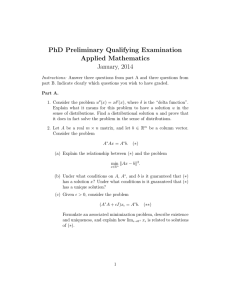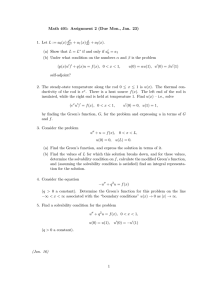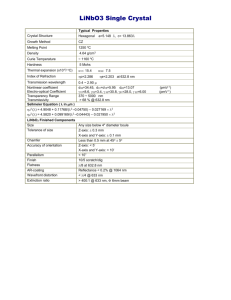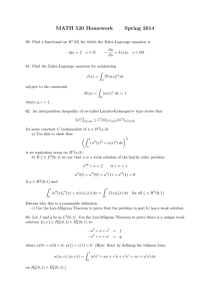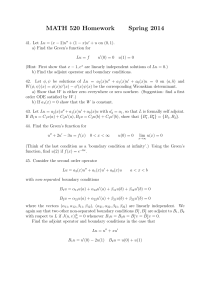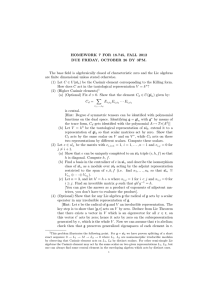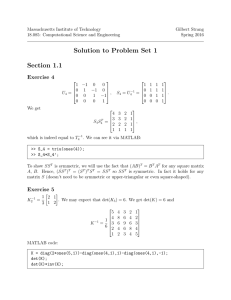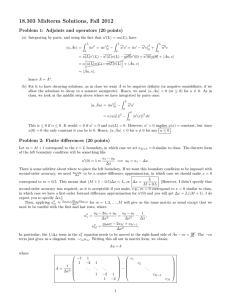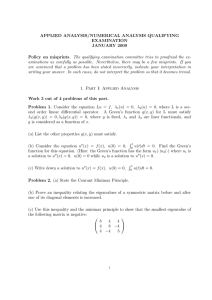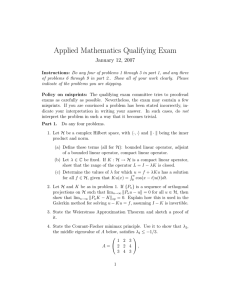Research Statement
advertisement
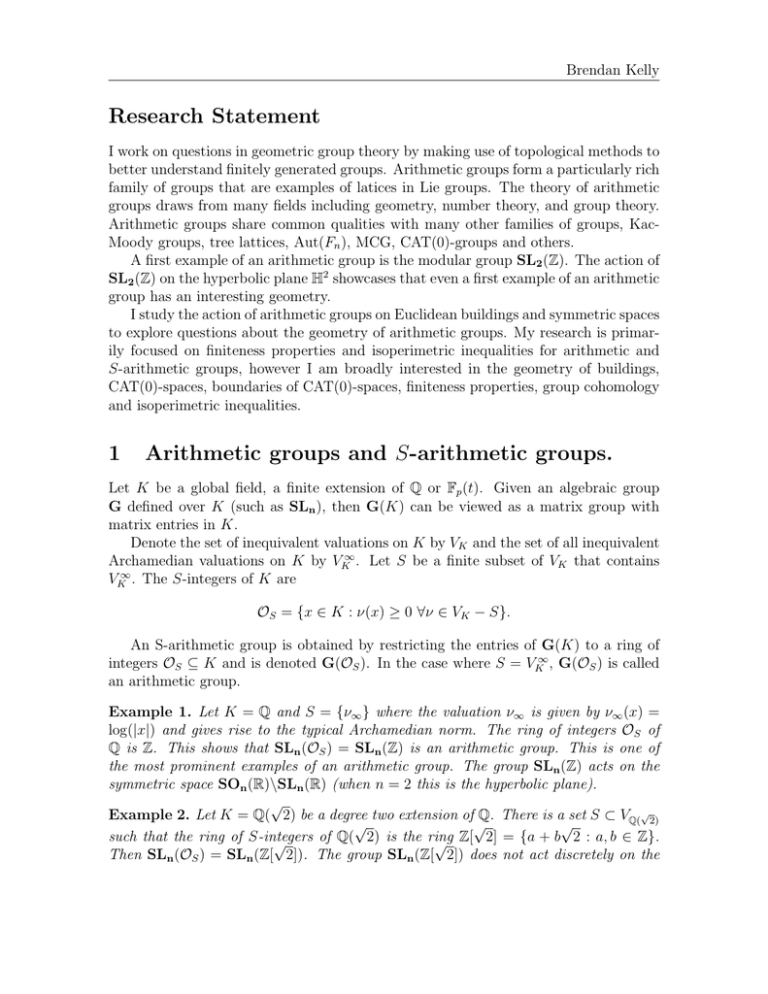
Brendan Kelly
Research Statement
I work on questions in geometric group theory by making use of topological methods to
better understand finitely generated groups. Arithmetic groups form a particularly rich
family of groups that are examples of latices in Lie groups. The theory of arithmetic
groups draws from many fields including geometry, number theory, and group theory.
Arithmetic groups share common qualities with many other families of groups, KacMoody groups, tree lattices, Aut(Fn ), MCG, CAT(0)-groups and others.
A first example of an arithmetic group is the modular group SL2 (Z). The action of
SL2 (Z) on the hyperbolic plane H2 showcases that even a first example of an arithmetic
group has an interesting geometry.
I study the action of arithmetic groups on Euclidean buildings and symmetric spaces
to explore questions about the geometry of arithmetic groups. My research is primarily focused on finiteness properties and isoperimetric inequalities for arithmetic and
S-arithmetic groups, however I am broadly interested in the geometry of buildings,
CAT(0)-spaces, boundaries of CAT(0)-spaces, finiteness properties, group cohomology
and isoperimetric inequalities.
1
Arithmetic groups and S-arithmetic groups.
Let K be a global field, a finite extension of Q or Fp (t). Given an algebraic group
G defined over K (such as SLn ), then G(K) can be viewed as a matrix group with
matrix entries in K.
Denote the set of inequivalent valuations on K by VK and the set of all inequivalent
Archamedian valuations on K by VK∞ . Let S be a finite subset of VK that contains
VK∞ . The S-integers of K are
OS = {x ∈ K : ν(x) ≥ 0 ∀ν ∈ VK − S}.
An S-arithmetic group is obtained by restricting the entries of G(K) to a ring of
integers OS ⊆ K and is denoted G(OS ). In the case where S = VK∞ , G(OS ) is called
an arithmetic group.
Example 1. Let K = Q and S = {ν∞ } where the valuation ν∞ is given by ν∞ (x) =
log(|x|) and gives rise to the typical Archamedian norm. The ring of integers OS of
Q is Z. This shows that SLn (OS ) = SLn (Z) is an arithmetic group. This is one of
the most prominent examples of an arithmetic group. The group SLn (Z) acts on the
symmetric space SOn (R)\SLn (R) (when n = 2 this is the hyperbolic plane).
√
Example 2. Let K = Q( 2) be a degree two extension of Q. There is a set S ⊂ VQ(√2)
√
√
√
such that the ring of S-integers
of Q( 2) is the ring
√
√ Z[ 2] = {a + b 2 : a, b ∈ Z}.
Then SLn (OS ) = SLn (Z[ 2]). The group SLn (Z[ 2]) does not act discretely on the
Brendan Kelly
symmetric space for SLn (R) however it does act discretely on a product of symmetric
spaces
SOn (R)\SLn (R) × SOn (R)\SLn (R)
√
one for each embedding of Z[ 2] into R.
Example 3. Let K = Q and let S = {ν∞ , νp }. The valuation νp is the p-adic valuation
given by νp (x) = n where x = pn ab and p does not divide a or b. Then OS = Z[ p1 ] and
SL2 (OS ) = SL2 (Z[ p1 ]). Note that SL2 (Z[ p1 ]) is not a discrete subgroup of SL2 (R) or
SL2 (Qp ), however, it is a discrete subgroup of SL2 (R) × SL2 (Qp ) (via the diagonal
embedding). The group consequently acts discretely on H2 × Tp - the product of a
hyperbolic plane and regular (p + 1)-valent tree.
These examples illustrate the general case. For ν ∈ S let Kν be the completion of
K with respect to the norm induced by ν. If Kν is an Archimedean field, G(Kν ) acts
on a symmetric space Xν . If Kν is not an Archimedean field, then G(Kν ) acts on a
Euclidean building Xν . In this way a space associated to
Y
G=
G(Kν )
ν∈S
is taken to be the product:
X=
Y
Xv .
v∈S
The group G(OS ) embeds diagonally into G and therefore there is an action of the
S-arithmetic group G(OS ) on X - the product of symmetric spaces and Euclidean
buildings.
2
Finiteness properties.
Definition 1. A group G is said to be of type Fm if G acts freely on a contractible
CW complex X such that the m-skeleton of G\X is finite.
Many results about finiteness properties for S-arithmetic groups depend on the sum
of the local ranks:
Definition 2. For any field extension L/K, the L-rank of G, denoted rankL G, is the
dimension of a maximal L-split torus of G. For any K-group G and set of places S,
we define the nonnegative integer
X
k(G, S) =
rankKv G.
v∈S
This number is called the sum of the local ranks and is the same as the dimension of a
maximal Euclidean flat in X.
Brendan Kelly
Bux-Köhl-Witzel recently proved the Rank Theorem, showing that every S-arithmetic
subgroup Γ of a noncommutative K-isotropic absolutely almost simple group G defined
over a global function field K is of type Fk(G,S)−1 but is not of type Fk(G,S) [BKW13].
Applying this theorem to SLn (Fp [t]) shows that SLn (Fp [t]) is of type Fn−2 but not
of type Fn−1 . A main technique in this process is considering the action of Γ on a
Euclidean building.
The group SLn (Z[t]) is not an arithmetic group. However, many of the techniques
used for arithmetic groups can be employed to gain results about finiteness properties of
SLn (Z[t]). This is because SLn (Z[t]) ⊆ SLn (Q((t−1 ))) and since Q((t−1 )) is a discrete
valuation field there is a Euclidean building that SLn (Q((t−1 ))) acts on.
If a group G is of type Fm , then by definition (using the cellular chain complex of
X) there is a free resolution of the trivial ZG-module Z which is finitely generated up
to dimension m. This suggests the following weakening of the finiteness condition Fm .
Definition 3. A group G is of type F Pm (with respect to Z) if there is a projective
resolution of the trivial ZG-module Z that is finitely generated up to dimension m.
It is clear that if a group is Fm then it is F Pm . In [BB97], Bestvina and Brady give
an example to show that F Pm is strictly weaker than Fm (see example 6.3.3).
In [BMW10], Bux-Mohammadi-Wortman make use of action of SLn (Z[t]) on the
Euclidean building for SLn (Q((t−1 ))) and Brown’s filtration criterion [Bro87] to show
that SLn (Z[t]) is not F Pn−1 .
If a finitely generated group G is of type F Pm then H m (G; R) is a finitely generated
R-module. However, if a group fails to be F Pm then it is not necessarily the case
that H m (G; R) is an infinitely generated R-module. So asking if Hm (G, −) is finitely
generated becomes an interesting question even when we know that G is not F Pm .
The result of Bux-Mohammadi-Wortman raises the following question.
Question 2.1. Is H n−1 (SLn (Z[t]); Q) an ifinite dimensional vector space?
I have am working on this question in collaboration with Cesa. Our contribution
to this question will be demonstrating that there is a family of subgroups of SLn (Z[t])
such that for every Γ in the family of subgroups, H n−1 (Γ; Q) is infinite dimensional
[CK13].
Definition 4. Given any ring A and a proper ideal I ⊆ A, the subgroup
SLn (A, I) = ker(SLn (A) → SLn (A/I))
is called a principal congruence subgroup of SLn (A).
Theorem 2.1 (Cesa-Kelly). Fix n ∈ N. Let I ⊂ Z[t] be a nontrivial ideal. If n ≥ 3
then we further assume that I ∩ Z = (0). Then H n−1 (SLn (Z[t], I); Q) is infinite
dimensional.
Brendan Kelly
The proof of Theorem 2 again makes use of the action of (SLn (Z[t], I) on Euclidean
building for SLn (Q((t−1 ))) and constructs an explicit family of independent cocycles.
The heart of the argument makes calculations about the cohomology of the link of a
vertex (which is a spherical building) and uses an averaging technique to produce a
global cocycle on the building.
Theorem 2 does not answer the question of whether H n−1 (SLn (Z[t]); Q) is infinite
dimensional and this remains an open question of interest to me.
Wortman has made progress on an analogous question for SLn (Fp [t]) and has shown
that there is a finite index subgroup Γ ≤ SLn (Fp [t]) such that H n−1 (Γ; Fp ) is infinite
dimensional [Wor13].
Bux-Wortman have used an action of SL2 (Z[t, t−1 ]) on the product of two buildings
to show that SL2 (Z[t, t−1 ]) is not F P2 and Cobb has extended this result to give a new
proof of Knusdon’s theorem that H 2 (SL2 (Z[t, t−1 ]); Q) is infinite dimensional [BW06],
[Cob13] , [Knu08]. This work raises the following interesting question:
Question 2.2. Is SLn (Z[t, t−1 ]) type F P2(n−1) ? Is H 2(n−1) (SLn (Z[t, t−1 ]; Q) infinite
dimensional?
It is also of interest to consider other algebraic groups such as the symplectic group
Sp2n . By studying the Euclidean building for Sp2n (Q((t−1 ))) it is likely one should be
able to prove results about finiteness properties of Sp2n (Z[t]) by generalizing techniques
from [BMW10],[CK13], [Cob13],[Kel13a],[Wor13].
Question 2.3. Is Sp2n (Z[t]) of type Fk ? Is H k (Sp2n (Z[t]); Q) an infinite dimensional
vector space?
2.1
Solvable Groups
For solvable arithmetic groups defined over function fields results about finiteness properties are not predicated on the the rank of the group. In [Bux04], Bux shows that
if G is a Chevalley group and B ≤ G is a Borel subgroup, then B(OS ) is of type
F|S|−1 but not type F P|S| . As a special case, if Bn the Borel subgroup of SLn of upper
triangular matrices then Bn (OS ) is not of type F P|S| . I have contributed the following
strengthening of Bux’s theorem in this special case [Kel13a].
Theorem 2.2 (Kelly). Let S be a finite set of discrete valuations on Fp (t). There is
a finite index subgroup Γ of Bn (OS ) such that, if p 6= 2, the vector space H |S| (Γ; Fp ) is
infinite dimensional.
Example 4. There is a finite index subgroup Γ of Bn (F3 [t, t−1 ]) such that H 2 (Γ; F3 )
is infinite dimensional.
This theorem is proved by generalizing techniques of [CK13], making use of observations from [Bux04] and looking at the action of B2 (OS ) on a product of trees.
Brendan Kelly
2.2
Isoperimetric Inequalities
Filling invariants for a group provide insight to the group’s large scale geometry. The
most well studied invariant is the Dehn function, which describes the difficulty of filling
a closed curve with a disk. Higher dimensional analogues can be similarly phrased. One
path to pursue is to investigate functions that describe the difficulty of filling an n-cycle
by an (n + 1)-chain.
It is a standard result that the diagonal embedding makes the S-arithmetic group
G(OS ) a lattice in G. The group G(OS ) acts on X in a natural way via this embedding.
The action of G(OS ) on X is not necessarily cocompact. Therefore, as a geometric
model for G(OS ) take a closed metric neighborhood of the G(OS ) orbit of some point
x. Label this subspace of X as XOS .
Given a n-cycle Y ⊆ XOS , let vXOS (Y ) be the infimum of the volumes of all (n + 1)chains B ⊆ XOS such that ∂B = Y . Now we can quantify the difficulty of filling an
n-cycle by the function
Rn (G(OS ))(L) = sup{vXOS (Y ) : vol(Y ) ≤ L}.
There are some choices made in the definition of Rn (G(OS ))(L) however all these
choices do not change the asymptotic class of Rn (G(OS )). In general results are stated
about the asymptotic class of these filling functions.
Question 2.4. For a given S-arithmetic group G(OS ) what are the asymptotics of
Rn (G(OS ))(L)?
Some progress has been made answering this question. If we fix n = 1, this is
equivalent to asking about the Dehn function for G(OS ). Examples of non-cocompact
arithmetic groups where the Dehn function has been calculated include:
SL2 (Z)
linear
SL3 (Z)
exponential
SLn (Z) ; n > 4 quadratic
exponential
SL2 (Z[ p1 ])
SL2 (Z) is hyperbolic
Epstein- Thurston [ECH+ 92]
Young [You13]
Taback [Tab03]
Note that the Dehn function for SL4 (Z) is unknown; Thurston conjectured that it is
quadratic.
The following conjecture of Leuzinger-Pittet has informed my work in the area
[LP96].
Conjecture 2.1 (Leuzinger-Pittet). If G is a connected, semisimple, Q-group that is
almost simple over Q and is Q-isotropic, then RrankR G−1 (G(Z)) is bounded below by an
exponential function
In [Wor11], Wortman contributes the following theorem
Brendan Kelly
Theorem 2.3 (Wortman). Let G be a connected semisimple, Q-group that is almost
simple over Q. Assume that G is Q-isotopic. Furthermore, suppose the Q-relative root
system of G is of type An , Bn , Cn , Dn , E6 , or E7 . Then there exist constants C > 0 and
L0 > 0 such that
RrankR G−1 (G(Z))(L) ≥ eCL
I am currently working on the following conjecture that puts much of what is known
into a common language of S-arithmetic groups [Kel13b].
Conjecture 2.2. Let K be a number field and S a finite set of inequivalent valuations
on K and let G be a noncommutative, K-isotropic, absolutely almost simple, K-group.
There exists a C > 0 and an L0 > 0 such that
Rk(G,S)−1 (G(OS ))(L) ≥ eCL for all L > L0 .
To date I have been able to make progress on Conjecture 2.2 and am able to prove
the conjecture so long as G is of type An , Bn , Cn , Dn , E6 , or E7 [Kel13b]:
In particular this proves that
Proposition 2.4 (Kelly). Let Γ = SLn (Z[ p1 ]). There exist constants C > 0 and L0 > 0
such that
R2n−3 (Γ)(L) ≥ eCL
As a special case this proposition includes a new proof that SL2 (Z[ p1 ]) has exponential Dehn function.
References
[BB97]
M. Bestvina and N. Brady, Morse theory and finiteness properties of groups,
Inventiones mathematicae 129 (1997), 445–470.
[BKW13] K.-U. Bux, R. Kohl, and S. Witzel, Higher Finiteness Properties of Reductive Arithmetic Groups in Positive Characteristic: The Rank Theorem,
Annals of Mathematics 177 (2013), 311–366.
[BMW10] K.-U. Bux, A. Mohammadi, and K. Wortman, SL(n, Z[t]) is not F P n−1 ,
Commentarii Mathematici Helvetici 85 (2010), 151–164.
[Bro87]
K. Brown, Finiteness porperties of groups, J. Pure Appl. Algebra 44 (1987),
45–75.
[Bux04]
K.-U. Bux, Finiteness properties of soluble arithmetic groups over funcion
fields, Geometry Topology 8 (2004), 611–644.
Brendan Kelly
[BW06]
K.-U. Bux and K. Wortman, A geometric proof that SLn (Z[t, t−1 ]) is not
finitely presented, Algebr. Geom. Topol. 6 (2006), 839–852.
[CK13]
M. Cesa and B. Kelly, Congruence subgroups of SLn (Z[t]) with infinite dimensional cohomology, In preperation. (2013).
[Cob13]
S. Cobb, H 2 (SL2 Z[t, t1]); Q) is innite-dimensional, Preprint (2013).
[ECH+ 92] D.B.A. Epstein, J. Cannon, D. Holt, S. Levy, M. Paterson, and
W. Thurston, Word processing in groups, Jones and Bartlett Publishers,
1992.
[Kel13a]
B. Kelly, A finite index subgroup of H |S| (Bn (Os ); Fp ) with infinite dimensional cohomology., Preprint. (2013).
[Kel13b]
, Higher dimensional isoperimetric functions for non-cocompact
arithmetic and S-arithmetic groups, In preperation. (2013).
[Knu08]
K. Knusdon, Homology and finitenss properties of for SL2 (Z[t, t−1 ]), Algebr.
Geom. Topol. (2008).
[LP96]
E. Leuzinger and C. Pittet, Isoperimetric inequalities for lattices in semisimple lie groups of rank 2., Geom. Funct. Anal 6 (1996), 489–511.
[Tab03]
J. Taback, The dehn function of P SL(2, Z[1/p]), Geom. Dedicata 102
(2003), 179 –194.
[Wor11]
K. Wortman, Exponential higher dimensional isoperimetric inequalities for
some arithmetic groups, Geom. Dedicata. (2011).
[Wor13]
, On the cohomology of arithmetic groups over function fields,
preprint (2013).
[You13]
R. Young, The dehn function of SL(n; Z), Annals of Mathematics 177
(2013), 969–1027.
